|
|
The Thunder Child: Interviews
An interview with Steve Vertlieb, page 2
In which Steve discusses Hammer's premiere soundtrack composer James Bernard,
The Monster Times, Ray Harryhausen, Kreating Karloff, and more!
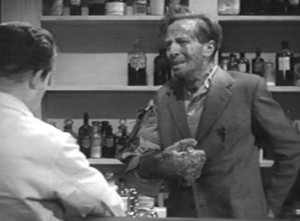
The unfortunate astronaut in The Quatermass Xperiment
| 4. You contributed a personal tribute to British composer James Bernard for the anthology, Memories of Hammer. Do you have any knowledge of Bernard?s work on the Quatermass movie that you?d care to share? |
The Quatermass Experiment (The Creeping Unknown in the U.S.) was Jimmy?s first film work. He?d been writing music for the radio in Britain. Anthony Hinds was producing the film version of Nigel Kneale?s cult television series, and had hired composer John Hotchkis to write the music. When Hotchkis fell ill, Hinds went to John Hollingsworth in a panic and asked if he could suggest someone else to score the picture. Hollingsworth brought over a tape of Jimmy?s music for a radio program he?d written called The Duchess of Malfi. Hinds liked what he heard and, suddenly, Jimmy was in the picture business.
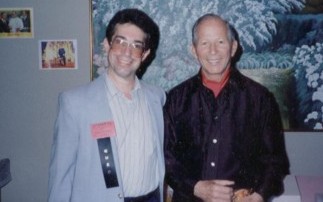
With the wonderful, sensitive James Bernard...
Hammer Film's gifted composer
Jimmy went on, of course, to become the premiere composer at Hammer, scoring Quatermass II, X-The Unknown (Quatermass without Quatermass) and most of the Dracula and Frankenstein productions with Peter Cushing and Christopher lee. Jimmy enjoyed working on the Quatermass series, but never felt that they would lend themselves to coherent suites in recent re-recordings. He agonized over whether or not to include them in compilations of his work. I assured him that they would, and that admirers of his music would love to have such suites made available in album form.
| I knew Jimmy for seven years. He would telephone me frequently from his home in London. He felt proudest of the romantic cues he?d written, but was at times insecure about the effectiveness of his more horrific themes. After years of personal challenge and tragedy, he retired from the screen. Some years later he returned from retirement to write his first original score in some time?the score for the painstaking restoration of Murnau?s silent classic Nosferatu. Silva Screen recorded his score and released it on CD. |
After years of personal challenge and tragedy, he retired from the screen. |
I listened to the album with tears in my eyes. It was obviously Jimmy. It sounded as good as the best of his classic scores for Hammer, and yet it was also fresh, exciting and new. I remember writing him of my admiration for his newest work, and remarking that I felt it was easily the best original film score of the year. He was so happy with my appraisal of his music that he telephoned me early on a Sunday morning from London to thank me for my kind comments. I said ?No, Jimmy?Thank YOU for your wonderful music.?
As successful as his newest score was, however, Jimmy was never able to break back into the picture business or enjoy a new career. There were sporadic television documentaries and TV commercials but, like others of his time and musical temperament, he had fallen victim to changing tastes and styles. I wrote Elmer Bernstein, asking if he could help Jimmy find some work, or offer any suggestions as to how he might, or who he might contact. Bernstein was most sympathetic and supportive, but wrote that today?s producers only want to use ?kids.? He went on to write that he was an unusual case, and lucky to still be working. He described himself, however, as a ?dinosaur.? It wasn?t long after that that Jimmy grew ill and passed away. I can?t help thinking that his various illnesses and ultimate passing were due to his heartbreak over not being able to work. He was a dear, gentle man. I had another note from Elmer Bernstein after Jimmy?s death, expressing his sorrow at the news of Jimmy?s passing. I shared that sorrow, and still miss his telephone calls and letters.
|
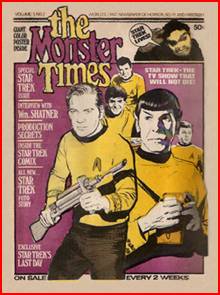
| 5. You served as Associate Editor and frequent contributor to New York?s groundbreaking film tabloid, The Monster Times. Could you share the history of the creation and end of The Monster Times? |
Well, it certainly was an ambitious project?to put out a new monster publication every two weeks. I never quite understood just how they felt that they could come up with enough material to fill an issue twice a month. It kept a hand full of writers and artists very busy for a time. As I said earlier, Allan Asherman and I were among the first writers they hired, and our efforts are pretty much all over those earliest issues. My work on King Kong was the featured article and cover story in the very first issue. Either Bernie Wrightson or Gray Morrow, as I recall, drew the cover illustration and we used stills from my collection.
Chuck McNaughton was a very nice man, but I could see early on that the pressures of editing a bi-weekly tabloid were wearing thin. He was normally quite a gracious soul but, after a time, the graciousness began to succumb to anger and growing frustration over his inability to remain on top of things. Eventually, I believe, he was replaced. The tabloid was never the same after that. Brill and Waldstein, the publishers, were money men, rather than creative writers. Their bottom line was the proverbial buck, and that buck did stop with them.
I remember one of them (Brill, I think) telling me that the world today consisted of ?graphics,? and that ?the printed word was on its way out.? It was his way, I guess, of putting me in my place and refusing to coddle his stable of writers. I began to lose interest in writing for The Monster Times after the William Shatner interview was published.
In 1969, when Star Trek was airing its final episodes on NBC television, William Shatner was filling his schedule with work in Summer theatre. He was set to star in a live production of the Broadway comedy There?s A Girl In My Soup at the Playhouse in the Park in the Philadelphia suburbs. I had arranged to interview him for the British magazine L?Incroyable Cinema. Allan Asherman had been visiting my brother, Erwin, and I at our parent?s house that week and so I took both Erwin and Allan with me to the interview. I had been working on the questions I?d ask Shatner, and had them neatly typed up. I brought a large tape recorder with me and struggled carrying it in the noonday sun.
| Shatner was very charming and quite funny. I asked him the majority of the interview questions. However, Allan or Erwin might jump in from time to time. When we left the theatre, I transcribed everything onto my old typewriter?wrote an introduction?and mailed it off to England. |
Shatner was very charming and quite funny |
As published in L?Incroyable Cinema, the article was titled "Inside A Starship Captain" by Steve Vertlieb, with Erwin Vertlieb and Allan Asherman. A few years later, the folks at The Monster Times asked permission to re-publish the interview. I said that they could do so, as long as they gave the proper credit to the original magazine. When their version of the interview was published in the paper, it read??Written by Allan Asherman, with the Vertlieb brothers.? I was not happy, and let them know it. They replied, somewhat smugly, that Allan had a bigger name and reputation than I, which was why the ?credit? went mostly to him. When Allan?s first book on Star Trek was published some years later, the Shatner interview was included and the credits still read the same way. To his credit, however, Allan, offered us a special acknowledgement in the book. When I voiced my annoyance again after so many years, a small voice in my head said back sarcastically ?Forget it, Jake. It?s Chinatown.?
|
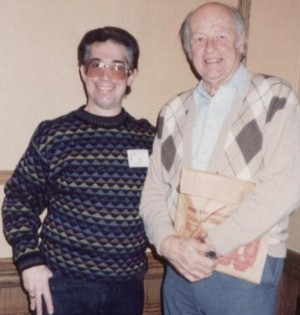
With personal hero and treasured friend...Ray Harryhausen
| 6. You hosted a personal appearance by Oscar-winning special effects genius, Ray Harryhausen. Can you give some history behind this? When and where did this take place? |
The event occurred in Baltimore, Maryland, I believe, at one of the annual Fanex conventions. The year would have been somewhere around 1991. My memory is a trifle hazy. Ray and Diana Harryhausen had flown in from their home in London to appear at the convention. I?ve known Ray since early 1966, and we?ve been good friends for all of those forty years.
Actually, Ray and I were introduced by Merian C. Cooper who, of course, Ray worked for on the production of Mighty Joe Young back in 1949. Cooper was kind enough to write Ray a letter of introduction, advising him that he?d be hearing from me. We?d corresponded all those years, without ever having met, until the release of Clash of the Titans in 1981. Ray was going to appear at Temple University here in Philadelphia. I?d learned of the event from a tiny notice in the local papers, and grew terribly excited at the prospect of meeting one of my heroes after fifteen years of correspondence.
I told him that he could throw me out of the building if Ray Harryhausen didn?t know who I was |
I figured that the theatre would be packed, and that I?d have a hell of a time trying to reach him?unless I could somehow wangle my way back stage prior to the lecture. I can remember quite clearly walking toward the ?Green Room? back stage, and being confronted by a mean looking armed guard standing in front of the door. I told him that I was an old friend of Harryhausen?s and that, once inside the room, the famed special effects man would embrace me. |
The guard eyed me more than a little suspiciously, so I told him that he could throw me out of the building if Ray Harryhausen didn?t know who I was. My heart was in my mouth as the officer reluctantly opened the doors and allowed me to walk in. There, ahead of me, was a living legend seated at a table talking with his wife. As I approached, he stood to greet me. I could literally feel the hot breath of the suspicious guard, his hand resting on his loaded weapon, ready to grab me from behind.
?Mr. Harryhausen,? I said. ?We?ve corresponded for many years. My name is Steve Vertlieb.? At that, Ray began smiling broadly and extended his hand. ?Steve Vertlieb,? he bellowed at the top of his lungs. Turning back to face his wife, he cried ?Oh My God, Diana?it?s Steve Vertlieb.? I thought my heart would burst with excitement and relief. I could sense the armed guard backing away from us and closing the door behind him. I sat with Ray for about a half hour before his scheduled appearance and enjoyed the time of my life.
Since that memorable afternoon I?ve been with Ray on many occasions. Knowing of my relationship with Harryhausen, Gary and Sue Svehla (the organizers of Fanex) asked if I?d be kind enough to share the stage with him, and field questions from the audience of five hundred fans. We shared the stage for roughly an hour and a half. Knowing Ray?s love of film music, I took advantage of my role as host and asked him about working with Bernard Herrmann and Miklos Rozsa on some of his pictures. He loved discussing their scores, and his personal relationship with these artists. Then something quite remarkable happened. When the appearance ended, Ray packed up his models and I helped him carry them out of the theatre and into the lobby of the hotel.
Ray was mobbed by adoring fans to my left, while I began walking in the other direction to allow him a few moments with his admirers. As I turned to leave, a young man approached me. He was with a woman and a small boy. ?Aren?t you the man who just shared the stage with Ray Harryhausen,? he asked? I said that I was. He noted that I had discussed the work of Bernard Herrmann from the stage. Once more, I acknowledged that I had. He pointed to the woman, who he identified as his wife, and the boy who he identified as his son. ?I?d like you to meet Bernard Herrmann?s daughter and grandson,? he said. ?My boy wanted to meet the man who had worked with his grandfather.? I think I must have clutched my heart in surprise. My gasp was audible and loud. I walked the pair over to where Ray was standing. ?Ray,? I interrupted, pointing to the woman and small boy. ?I?d like you to meet Bernard Herrmann?s daughter and grandson.? Ray gasped, as I had done, and embraced the pair. It was a moment I don?t think I?ll ever forget.
|
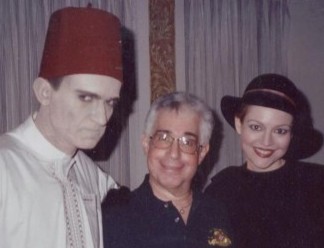
Another chance to see the Kreating Karloff team.
| 7. You recently recorded a documentary for Conor Timmis? film, Kreating Karloff. Can you give some background on the history of this? |
Well, I was asked by Red Hot Planet to do a featured article on the life and career of Boris Karloff. Sara Karloff, the actor?s daughter, saw my work and asked permission to spotlight the article as the centerpiece of her own official Boris Karloff web site. I was honored, to say the least, and gave her my enthusiastic permission. A friend of hers, a young working actor named Conor Timmis, saw the piece on the Karloff web site, and set about contacting me on line. Sara believed in Conor?s talent as a performer and managed to arrange for a screen test on Superman Returns. He didn?t get the part but turned his attention, instead, to his favorite actor, Sara?s illustrious father, Boris.
My first assignment was to pen the official press release for the film, now called Kreating Karloff |
Conor wrote me of his affection for my biographical salute, and asked if I?d like to become involved in a project he was planning that might re-imagine the classic creatures originally brought to life by Boris Karloff. My first assignment was to pen the official press release for the film, now called Kreating Karloff. We had many conversations in the months ahead, both on line and by telephone. His initial concept, of a film within a film, was to have served as an audition for the lead in a proposed motion picture biography of Karloff, in which Conor would play the horror star. A short biographical sketch of the late actor would begin the documentary, in order to set the proper mood for the recreations, and I was asked to both write and narrate the eight minute preface. |
I wrote the copy, and then recorded my narration at a small sound studio in New Jersey. After that, I was invited to join the cast and crew at Tripeg Studios in Hamden, Connecticut, where the scenes with Conor as The Mummy and Frankenstein?s Monster would be photographed. I observed the two day shoot at the end of May, 2006 and, again at Conor?s request, wrote an article about the production called "Under The Stars of Egypt: The Filming of Kreating Karloff" which appeared on Red Hot Planet. While in Connecticut, I found myself in front of the cameras as part of Vatche Arabian?s documentary on the making of the sequences. Meanwhile, Conor and Vatche came to the conclusion that the narration and script I?d written and performed, highlighting Karloff?s career, slowed the pace of the picture and decided, regretfully, to eliminate it. I suggested that, perhaps, when the completed documentary is made available commercially on DVD, that they consider including my narration and script as a part of the extra material included in the package.
|
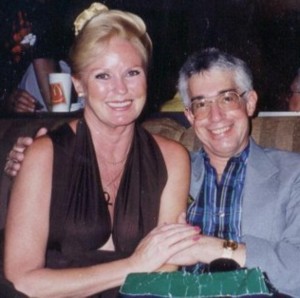
With my exquisite Veronica Carlson...as lovely within as without.
| 8. For most of your writing, are you approached or do you go out and solicit assignments? |
I used to go out and solicit when I was a younger man, but I grew tired of standing in police lineups. Having said that, editors generally contact me with a specific request for an article or type of article. I may receive a list of topics to choose from for a proposed volume, and then I select the one that I?m most comfortable with, or challenged by. |
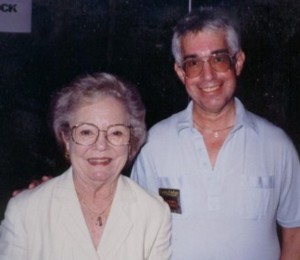
With Patricia Hitchcock...daughter of filmdom's greatest director.
| 9. If you?re approached to write something?how do you do your research? Do you work from an outline or do you just do the research and then let the words pour onto the page? |
I?ll start with a rough outline, containing some of the more important points or ideas I?d like to grapple with and explore. Then, after doing my initial research, I?ll jot down, sequentially, the observations I want to add to the text. After that, it?s merely a question of allowing my agenda to give voice to my opinions. I?ll often discover that, as I?m writing, one idea may give way or lead into another. Structure is, of course, essential to a writer?s work. You must know where you?re beginning, where you wish to go, and then determine how to arrive there. However, too much structure can put you into a box from which escape is prohibitive. I prefer to use only a very rough guideline, and then see where my thoughts and dreams may take me. |
| 10. If you go out and solicit assignments?ditto. What assignments do you choose ? are they something you know about thoroughly already, or does something catch your interest and ?ping? you to do research into, and then write about? |
Well, I don?t know that I?d be much good at writing about the political climate that we?re living in, or about the explosive situations in Iraq and the middle east?although I could. I certainly have strong opinions in those areas, as does most everyone who cares about the future of volatile humanity?but I?m inclined to write in the areas and forums that pique my imagination and interest?the areas that bring a smile to my lips, rather than a scowl. There?s entirely too much depravity and misery in the world without my adding to it. I?ve always been ?drawn? (as was Norman Rockwell) to film and literary flights of fancy. I find the unknown far more enticing and provocative than the known worlds in which we reside. I prefer to dwell, then, in spheres of utopian fantasy, science fiction and, you should excuse the expression, ?horror?? worlds in which the Pan (to utilize the Peter Principle) would find comfort and fulfillment. |
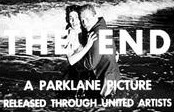
| 11. For your Kiss Me Deadly chapter in a forthcoming anthology?do you consider Kiss Me Deadly a sci fi film? (Bill Warren includes it in his Keep Watching The Skies book because of the ending where the bomb explodes). |
That?s not only an explosive ending, but an explosive question. What is the definition of science fiction? If it?s the exploration of things that have not happened yet, but that could occur in a rational or scientific future?then, yes?Kiss Me Deadly IS a science fiction film. It is, however, many other things and combines the elements of many other genres. The ending which, conceivably, destroys all of the surrounding geography with the dreaded opening of Pandora?s Box (there she goes again) foretells the evils of nuclear misuse and irresponsibility. Bill Warren is correct in his analysis. However, the Robert Aldrich film certainly qualifies as film noir with its dark streets, shadows, and darker implications. It?s also a somewhat non-traditional detective film and erotic thriller. Mickey Spillane was busily tearing down conventional walls and barriers, fueled by the unrestrained testosterone of his sexually combative hero, Mike Hammer. Kiss Me Deadly, for all of its crudities and hydrogen innocence, is a fascinating hybrid of many and diverse filmic elements. It?s a film that, happily, refuses to be briefed, debriefed, stamped or numbered. What it is, however, is exciting filmmaking by an artist exploding, if you will, with youthful energy, enthusiasm, and exuberance. It?s rather like life itself. It can?t, or won?t be pigeon holed or labeled. Like you, I?ve seen many things?I?ve done many
things?I AM many things. But?that?s another story.
|

| 12. You've corresponded with many, many of our entertainment icons. Any special memories? |
One of the greatest joys of my life has been in receiving correspondence from, meeting and, in many cases, befriending the heroes and role models I?ve most respected and admired. Over the years I?ve been lucky enough to maintain correspondence with the likes of Frank Sinatra, Alfred Hitchcock, Frank Capra, John Wayne, Stanley Kubrick, Ray Bradbury, George Pal, Vincent Price, Robert Wise, Miklos Rozsa, Arthur C. Clarke, Buster Crabbe, Fay Wray, Bramwell Fletcher, Veronica Carlson and Peter Cushing. I got to meet Peter Cushing in New York at Forry Ackerman?s Famous Monsters Convention in 1974. When he emerged from the hotel elevator, I approached him and mentioned my name. He said??Oh, you used to write me with your brother?just like Laurel and Hardy.?
Buster Crabbe once searched the Philadelphia telephone directory to find my telephone number while in town for a convention. We later met for dinner in Chinatown and, much like a Jewish mother, he poured the remains of his own uneaten dinner into my plate to make sure that I had eaten enough.
I peed in adjoining urinals with Arthur C. Clarke the day after 2001: A Space Odyssey had opened in New York, and I told him how much I had loved the film. He appeared stunned, having been battered with initially negative reviews, and said ?you?re the first one to say that.? A year later in New York I saw him again, this time surrounded by adoring fans, and reminded him of our earlier conversation. Some little twit in the crowd said??Oh, sure, everyone says that now.?
Ray Bradbury wanted to show me his original Technicolor print of Moby Dick. It was a gift from John Huston, and he was very proud of it. We sat in his living room in Los Angeles, and I noticed a single hair brushing the projected image. I asked him if he?d cleaned the gate before running the film. He asked, quite innocently, what I meant. So, there I am in Ray Bradbury?s living room having the colossal stones to instruct him on the technique of cleaning one?s projector gate.
I bumped into Bramwell Fletcher in the late sixties in Atlantic City, New Jersey, where he was starring in a one man show based on the life of George Bernard Shaw. He invited us to his hotel room and regaled us with stories of working on Universal?s The Mummy with Boris Karloff. Kindly, he offered my brother and I tickets to that evening?s performance of the show. We remained friendly until his death.
I knew Frank Capra for several years, and sat with him at the home of a mutual friend watching a screening of It Happened One Night. Can you imagine??? Just Frank Capra and I sitting together on a bench watching his film.
On one memorable afternoon, somewhere around 1977, I spent a wonderful couple of hours in the company of Ann Darrow herself. Merian Cooper had always promised that if I ever came out west that he?d introduce me to Fay Wray. Coop had passed away, of course, in 1973. I managed, however, to take the gorilla by the fur, and write to Fay at her Century City apartment in Los Angeles. She was kind enough to invite us for an unforgettable afternoon in which she spoke quite lovingly of Merian Cooper, Robert Armstrong and that certain ?tall, dark, leading ape.? I could have leaped off the top of the Empire State Building when I opened a pressurized can of Coca Cola from Fay?s refrigerator, and it exploded?sending fountains of liquid all over her kitchen sink?proving that not all things ?go better with Coke.?
Ray Milland was a dignified and gentle artist near the end of his film career when we ran into one another in 1967 during a performance in Philadelphia of Hostile Witness. He was kind enough to pose for a photograph, but only after he requested a moment to put his hair piece in place upon his otherwise bald scalp. When signing a picture of himself at Paramount in 1936, he chuckled?asking ?Did I ever really look like that?? After his signature, he humorously added a question mark.
I stood next to John Wayne and Bruce Cabot at the old Stanton Theatre in Philadelphia in 1963 when Wayne and company were on tour promoting the release of Hatari. Wayne wrote me a lovely letter not long after that, and enclosed a still photograph from True Grit signed, simply, ?Rooster.?... but, perhaps, the greatest single thrill of my life was in going back stage to the dressing rooms at the Latin Casino in Cherry Hill, New Jersey to meet Frank Sinatra. He put his arm around me, and spoke for only a moment?but it was, and is, a moment frozen in time and memory. As George Bailey felt so profoundly in Frank Capra?s 1946 cinematic love letter?It truly is ?A Wonderful Life.?
|
| 13. You record programming for the blind community. What kind of material do you record? Can you give some background and history on this? |
Well, I haven?t actively recorded for the blind in about three years. As my jobs grew farther away from the radio station, it became harder and harder to keep up with the demands of a weekly broadcast. I did it virtually every week for twenty two and half years?from 1981 until late in 2003. I began by reading books and magazines onto tape. Then I became somewhat more specialized in my volunteer work, and focused on a weekly half hour program that previewed noteworthy films, series and specials airing on television in the week ahead.
Blind people listen to television, just as sighted viewers watch it. So, I would give capsule reviews and recommendations for the week ahead. I would frequently interject behind the scenes anecdotes and humor into the broadcasts, in order to keep them from becoming overly dry. For my work with the blind, I was inducted into the Legion of Honor by the Chapel of the Four Chaplains, a humanitarian society begun by President Truman in 1948.
|
Return to:
 |
Click on the icons for new features in The Thunder Child.
Radiation Theater: 1950s Sci Fi Movies Discussion Boards
The Sand Rock Sentinel: Ripped From the Headlines of 1950s Sci Fi Films
|
 |
|
Recommended Reading

Learn more or
Buy Now

Learn more or
Buy Now

Learn more or
Buy Now

Learn more or
Buy Now

Learn more or
Buy Now

Learn more or
Buy Now

Learn more or
Buy Now

Learn more or
Buy Now
|











